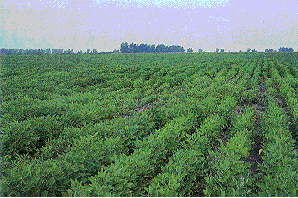
Effects of SCN in Soybeans
Courtesy of:
www.gov.on.ca/OMAFRA/english/crops/facts/90-119f3.gif

Last updated by
Nick Dolezal
on January 30, 2002
Common Names of Soybean Cyst
Nematodes:
-Nematodes
-SCN
Causal Agent:
Species:
Heterodera glycines
Phylum:
Nematoda
Order:
Tylenchida
Host Range:
Here are some of the alternate crops, ornamentals, and weeds that SCN
can survive on:
|
|
|
|
|
|
|
|
|
|
|
|
|
|
|
|
|
|
|
|
|
|
|
|
|
|
|
|
|
|
|
|
|
|
|
|
|
|
|
|
Geographical Range:
SCN originated in Asia and is now found throughout the world. SCN can be found in Japan, Colombia, United States, Taiwan, Egypt, and many other regions similar in climate to the areas listed. The nematode's ability to survive and spread throughout the world can be attributed to it's movement with soil and the wide number of host they can survive on.
Symptoms:
As seen on the photo on the top of this page, Soybean Cyst Nematodes can be devastating to a soybean crop. Often times, if a soybean field looks even in growth, and healthy, SCN symptoms may not be evident until the the crop is harvested and yield less than anticipated are discovered. In most situations, SCN can be diagnosed by observing chlorotic yellowing on soybeans in certain, often low-lying, areas of the field. Upon closer observation, the chlorosis can be seen as interveinal yellowing on the leaves. Often times the farmer or crop scout may place the blame for this condition on compaction, alkaline soil or iron chlorosis, herbicide injury, or even excessive moisture stress. during the right time within the pathogen's life cycle, the cysts will be visible to the naked eye. They can be found as little white spots on the roots. These spots are not to be mistaken for larger, nitrogen fixing nodules, which are more obvious when compared to SCN cysts.
Dissemination:
Basically, anything that can move soil, can transport and relocate nematodes. Wind, water, field equipment, humans, migratory birds, and other animals are just a few of the vehicles for nematodes to be moved on. Generally, whole cysts are not transported. The microscopic nematodes moving with the items listed above are what infects a soil and eventually soybeans
Disease Cycle:
The cyst part the SCN life cycle is really the dead body cavity of what is left of the once microscopic, female roundworm. the cyst serves as a protective covering for the young eggs which are harbored inside. Once the eggs hatch, the juveniles will search for roots to bury their stylet into. Each cyst may contain up to 500 eggs. The search for a root to feed on must not take long otherwise the small roundworm will die due to starvation. Once a root is found and the nematode begins to feed, it will molt into adulthood. Here the nematode will either develop into a male or female. Females remain immobile, embedded into the root. Males will pull away from the root and search for a mate to fertilize. Once this occurs, the cycle starts over again. This whole process can take from 24-30 days.
Control Measures:
SCN can never be totally taken out of a field once introduced. In order to control SCN, many measures can be taken. Jim Smolik, a nematologist at South Dakota State University, says that the best control of the parasitic roundworm is a good basic cultural practice, rotation. Rotation from non host crops like wheat or corn can break up the life cycle and constant reproduction of SCN. Soybeans resistant to SCN are available and should be used in a field with a history of SCN however, a good rotation schedule should be followed along with the most resistant varieties. The elimination of other host plants will reduce the number of nematodes produced. Also, the cleaning of equipment between transport from field to field will greatly reduce the spread of SCN. Anything that will reduce soil movement from field to field will help in limiting the nematode's movement. Below is an ad from the Soybean Cyst Nematode Coalition urging farmers to take the SCN test to see if they need to implement a control for the pest or not.
Related Journal Article:
Long, J. H., and Todd, T. C. Jul/Aug, 2001.
Crop Science Society of America
41:1137-1143.
The reason for the study performed here was to find ideas or methods of a cultural nature that will reduce the effects of SCN on soybeans in the Wisconsin region. There were four management systems on trial in the study. Of the four the best management practice would be almost exactly what Jim Smock states. Nematode levels can be be brought to an acceptable level by proper rotation and the use of SCN resistant varieties.
Sources:
Agrios, George N. 1997. Plant Pathology 4 ed. Academic Press.
pp. 577-579.
Ohio State University. Soybean Cyst Nematode Information Web site.
www.ohioline.osu.edu/ac-fact/0039.html.
Ontario Soybean Cyst Nematode Fact Sheet.
www.gov.on.ca/OMAFRA/english/crops/facts/90-119.htm
Smolik, James. 1999. Interview.
|
|
|
|
|
|
|
|
|
|
|
|